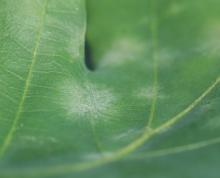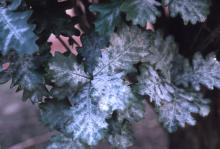Cause Erysiphe calocladophora, Erysiphe penicillata and Phyllactinia alnicola, (formerly Microsphaera sp.), fungi that have been reported from Oregon and Washington. The conidia are readily wind disseminated. Chasmothecia develop within the external hyphae and form appendages late in their development. This fungus is favored by conditions that produce high humidity but dry leaves. It is a highly specialized pathogen that forms a close association with the host. Conditions that favor the host also favor the pathogen. Much of the fungus remains outside infected plant parts where it grows on the surface but sinks root-like structures called haustoria into plant cells to obtain nutrients. The white growth seen is composed of both mycelium and fungal spores. The disease in France is seen more often in the spring when disease severity has been high in the fall.
Symptoms White powdery growth on the leaf surface. Leaves may be puckered or distorted where the colony has developed.
Cultural control
- Plant resistant cultivars such as Heritage Oak.
- Space nursery plants for good air circulation.
- Remove and destroy infected plant parts if practical.
Chemical control Fungicides will do best when used before symptoms develop. Few materials have good eradicant activity. Use at 7- to 14-day intervals; using shorter intervals when environmental conditions favor disease development. Alternate or tank-mix products from different groups that have different modes of action. Limit the use of any one group during crop production.
- Armada 50 WDG at 3 to 9 oz/100 gal water. Do not use a silicone-based surfactant. Not for nursery or greenhouse use. Group 3 + 11 fungicide. 12-hr reentry.
- Banner MAXX is labeled for oak leaf spot at 16 oz/100 gal water and may be effective against powdery mildew. Try on a few trees first before widespread use. Group 3 fungicide. 12-hr reentry.
- Eagle 20 EW at 6 to 12 fl oz/100 gal water. Group 3 fungicide. 24-hr reentry.
- Heritage at 1 to 4 oz/100 gal water plus a non-silicone-based wetter sticker. Group 11 fungicide. 4-hr reentry.
- Insignia at SC 3 to 6 fl oz/100 gal water. Do not use with organosilicate-based adjuvants. Use preventively only. Listed for Bur and red oak. Group 11 fungicide. 12-hr reentry.
- Myclobutanil 20 EW T&O at 6 to 12 fl oz/100 gal water plus spreading agent. May observe a PGR effect. Group 3 fungicide. 24-hr reentry.
- Orkestra at 6 to 8 fl oz/100 gal water. Group 7 + 11 fungicide. 12-hr reentry.
- Spectracide Immunox Multi-Purpose Fungicide Spray Concentrate for Gardens at 1 fl oz/gal water. Group 3 fungicide. H
- Tebuject 16 is registered for tree injections. The number of capsules used is based on tree size. Group 3 fungicide.
- Trinity at 4 to 12 fl oz/100 gal water. Group 3 fungicide. 12-hr reentry.
Reference Glawe, D.A. 2008. The powdery mildews: a review of the world's most familiar (yet poorly known) plant pathogens. Annu. Rev. Phytopathol., 46:27-51.
Marçais, B., Piou, D., Dezette, D., and Desprez-Loustau, M.L. 2017. Can oak powdery mildew severity be explained by indirect effects of climate on the composition of the Erysiphe pathogenic complex? Phytopathology 107:570-579.




